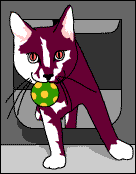Teaching a Cat to Fetch
Created | Updated Mar 9, 2005

It is a long-held misconception that dogs hold the monopoly on the simple game of fetch, and that to try the same game with a cat or kitten would result in that 'look' that every cat owner fears - one of astonished apathy.
Interestingly, cats appear to enjoy fetch as much as the next mutt, and here are some simple instructions to encourage your cat or kitten to participate in this activity.
How to Teach your Cat To Fetch
The number one rule in teaching a cat anything is, don't try to teach it. This will always result in disappointment. Try to encourage your cat. Play on your cat's natural playfulness and encourage it with fuss and treats and soft expressions of 'Good widdul kittypuff!'.
Don't go to any expense. Invariably, your cat will be so much more interested in a passing leaf than the Super-Sparkled Jingle-Studded Fetch Ball you spent 25 minutes choosing at the pet shop. For the sake of feline fetch, a scrunched-up ball of white envelope, wrapping paper or newspaper will suffice.
It is also worth noting that playing fetch works less well if you're using a catnip-scented/filled ball - many cats will be far more interested in getting high on the catnip than they will be in getting it back to you.
Get the cat interested in the paper. Choose a moment when it seems to have nothing better to do than stare at a shoe or clean its undercarriage on your favourite cushion. Rustle the paper, whip it around in circles. Get your cat's attention, then...
Throw the paper! This part is self-working and entertaining for both parties; just sit back and grin at your cat's inability to grip kitchen floor tiles.
If your cat is interested, it will proceed to bat the ball of paper around playfully. If it's not interested, it'll probably go back to perfecting its shoe-staring technique.
You have hopefully achieved the most crucial step in the whole construct of feline fetch - getting the animal interested. After this, it's downhill all the way home.
Let the cat have its way with the ball for a while, then retrieve it and encourage the cat to follow you back to your original position by rustling the paper, making squeaky noises and saying 'C'mere pudpudpudpudpud!'.
If all else fails, you may like to try tempting your cat back with the offer of some treats. However, it is worth noting that training cats is a little different from training dogs. With dogs it is something like this: trick-treat-trick-treat-trick-treat... but cats will become bored much more quickly.
Once the cat has returned, fuss it, tickle it kindly behind the ears, then repeat from step three.
It may take some time, but after a while - probably when you stop trying - the cat will gleefully return to you with the ball of paper in its mouth and stare at you expectantly. You may find it takes a few days of short practice sessions for both of you to perfect the technique but, once achieved, never again will you be able to throw away a cheap envelope in the company of friends.
Experimentation suggests that a cat will be happy with any size of scrunched-up ball, so long as it isn't bigger than the cat, and not shaped like a bulldog.

